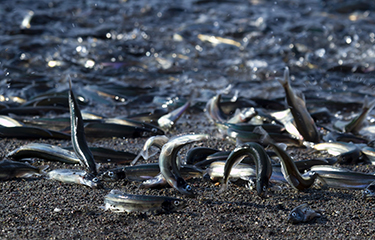Fresh opinion polling of concerned residents along with an amended fisheries act has conservationists optimistic the Canadian government will halt business at Newfoundland and Labrador’s troubled capelin fishery.
The fishery, which has been financially lucrative in the past, exports capelin roe to Japan as masago, commonly used as a topping for sushi rolls. Capelin catches are also commonly used in feed at aquariums and in fish oil and fishmeal production.
However, the fishery has experienced overfishing consistently for decades, putting stress on vital commercial stocks such as Atlantic cod and other marine animals such as whales and Atlantic puffin that depend heavily on the forage fish as a main food source.
Conservationists have long raised concerns over management of the fishery, and a new opinion poll commissioned by Oceana Canada and conducted by market research firm Abacus Data is showing an overwhelming majority of Newfoundland and Labrador residents supporting a suspension of fishing to help capelin stocks recover.
A total of 84 percent of respondents in the poll supported closing the fishery temporarily to help populations grow, while 82 percent agreed the Canadian government should be doing more to protect capelin and other fish that play an important role in larger ocean ecosystems.
It appears the government is paying attention to their concerns.
For the first time, Canada's Department of Fisheries and Oceans (DFO) set a reference point this year for capelin at 640,000 metric tons – which is a measure of total biomass in the water – delineating a threshold between cautious and critical zones. The latest stock assessments show catch levels are currently in the critical zone and have been there since 1991, when the stock collapsed.
Now, scientists including Jack Daly, a marine scientists working for environmental NGO Oceana Canada, are calling on Canadian Minister of Fisheries, Oceans, and the Canadian Coast Guard Joyce Murray to close the fishery entirely this year to help it recover
“I think what we would say, and what other environmental groups and some Indigenous groups would say, is that the science has never been clearer that the stock is [at] unhealthy [levels],” Daly told SeafoodSource. “Although there have been some things in the assessment [signaling] that the quality of capelin is better, it's really not better when we look at what it was 30 years ago.”
The most recent DFO assessment indicates capelin are spawning later and maturing earlier, which “sets them up for really weak recruitment classes,” Daly said.
Despite the positive indicators, Daly said it is too early to divert attention from rebuilding the stock, and more time is necessary to allow the quality to improve and reach the status of capelin caught in the Barents Sea and North Atlantic.
In 2022, the DFO established Newfoundland and Labrador’s capelin quota at 14,533 metric tons (MT), which is a tiny fraction of total capelin catch compared to Iceland and Norway. In 2022, Iceland recorded a capelin catch of 446,196 MT in Q1 alone.
Both Iceland and Norway have ...
Photo courtesy of Florence-Joseph McGinn/Shutterstock








